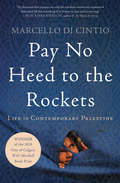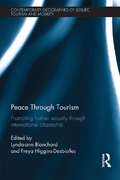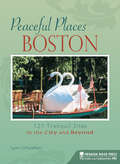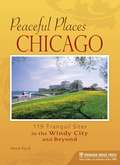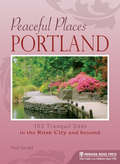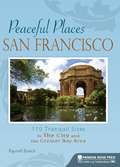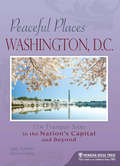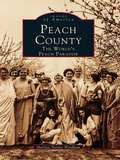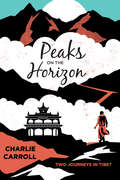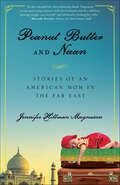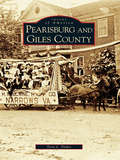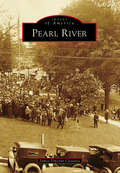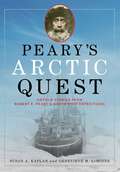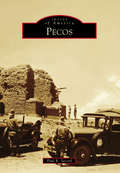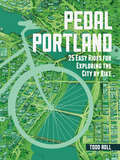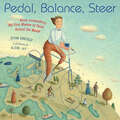- Table View
- List View
Pay No Heed to the Rockets: Life in Contemporary Palestine
by Marcello Di Cintio"With humility, respect, and great sensitivity, he seeks out writers, people skilled at telling stories, and asks them to narrate their own situations. The result is a document that captures not only the manifold sorrows and injustices of Palestinian life but something of its beauty, its joys, and its yearning." —Ben Ehrenreich, author of The Way to the Spring Taking the long route through the West Bank, into Jerusalem, across Israel, and finally into Gaza, Marcello Di Cintio meets with Palestinian poets, authors, librarians, and booksellers to learn about Palestine through their eyes. Pay No Heed to the Rockets offers a look at life in contemporary Palestine through the lens of its literary culture, one that begins with art rather than with war.
Payson
by Jayne Peace Pyle Jinx PyleBeneath the escarpment of the Mogollon Rim in Gila County lies Payson, Arizona. Founded as Green Valley in 1882 by ranchers and miners, the town site of Payson was laid out by local blacksmith James C. Callaghan and local merchant and cattle rancher John C. Hise. Two years later, local rancher and Native American fighter Charlie Meadows founded the Payson Rodeo in a mid-town meadow, which ultimately became the world's oldest continuous rodeo. When the cattle and timber industries declined, Payson evolved into a retirement and tourist destination. People looking for places to hike, bike, fish, hunt, and camp are attracted to the Payson area, which is also popular for its festivals and historic sites. A replica of Zane Grey's cabin stands next to the local museum, and the Tonto Natural Bridge is just 11 miles outside of town.
Peace Kills: America's Fun New Imperialism (Books That Changed the World)
by P. J. O'RourkeThe #1 New York Times-bestselling author who “never fails to find the absurd” addresses everything from airport security to the Iraq War (The New York Times Book Review).To unravel the mysteries of war, P.J. O’Rourke first visits Kosovo. (“Wherever there's injustice, oppression, and suffering, America will show up six months later and bomb the country next to where it's happening.”) He travels to Israel at the outbreak of the intifada. He flies to Egypt in the wake of the 9/11 terrorists' attacks. and contemplates bygone lunacies. (“Why are the people in the Middle East so crazy? Here, at the pyramids, was an answer from the earliest days of civilization: People have always been crazy.”) He covers the demonstrations and the denunciations of war. Finally he arrives in Baghdad with the U.S. Army, and enters one of Saddam's palaces. (“If a reason for invading Iraq was needed, felony interior decorating would have sufficed.”) With this collection, P.J. O’Rourke once again demonstrates that he is “an acerbic master of gonzo journalism and one of America’s most hilarious and provocative writers” (Time).
Peace Meals
by Anna BadkhenTravel books bring us to places. War books bring us to tragedy. This book brings us to one woman's travels in war zones: the locals she met, the compassion they scraped from catastrophe, and the food they ate.Peace Meals is a true story about conflict and food. It illustrates the most important lesson Anna Badkhen has observed as a journalist: war can kill our friends and decimate our towns, but it cannot destroy our inherent decency, generosity, and kindness--that which makes us human. Badkhen writes: There is more to war than the macabre--the white-orange muzzle flashes during a midnight ambush . . . the scythes of shrapnel whirling . . . like lawnmower blades spun loose; the tortured and the dead. There are also the myriad brazen, congenial, persistent ways in which life in the most forlorn and violent places on earth shamelessly reasserts itself. Of those, sharing a meal is one of the most elemental. No other book about war has looked at the search for normalcy in conflict zones through the prism of food. In addition to the events that dominate the news today--the wars in Afghanistan and Iraq--Peace Meals also bears witness to crises that are less often discussed: the conflict in Chechnya, the drought cycle in East Africa, the failed post-Soviet states, the Palestinian intifada. Peace Meals focuses on day-to-day life, describing not just the shocking violence but also the beauty that continues during wartime: the spring flowers that bloom in the crater hollowed by an air-to-surface missile, the lapidary sanctuary of a twelfth-century palace besieged by a modern battle, or a meal a tight-knit family shares in the relative safety of their home as a firefight rages outside. It reveals how one war correspondent's professional choices are determined not only by her opinion of which story is important but also by the instinctive comparisons she, a young mother, makes each time she meets children in war zones; by her intrinsic sense of guilt for leaving her family behind as she goes off to her next dangerous assignment; and, quite prosaically--though not surprisingly--by her need to eat. Wherever Badkhen went, she broke bread with the people she wrote about, and the simple conversations over these meals helped her open the door into the lives of strangers. Sometimes dinner was bread and a fried egg in a farmer's hut, or a packet of trail mix in the back of an armored humvee. Sometimes it was a lavish, four-course meal at the house of a local warlord, or a plate of rice and boiled meat at a funeral tent. Each of these straightforward acts of humanity tells a story. And these stories, punctuated by recipes from these meals, form Peace Meals. Following Badkhen's simple instructions, readers will taste what made life in these tormented places worth living.
Peace through Tourism: Promoting Human Security Through International Citizenship (Contemporary Geographies of Leisure, Tourism and Mobility)
by Freya Higgins-Desbiolles Lynda-Ann BlanchardPeace through tourism refers to a body of analysis which suggests tourism may contribute to cross-cultural understanding, tolerance and even peace between communities and nations. What has been largely missing to date is a sustained critique of the potential and capacities of tourism to foster global peace. This timely volume fills this void, by providing a critical look at tourism in order to ascertain its potential as a social force to promote human rights, justice and peace. It presents an alternative characterisation of the possibilities for peace through tourism: embedding an understanding of the phenomenon in a deep grounding in multi-disciplinary perspectives and envisioning tourism in the context of human rights, social justice and ecological integrity. Such an approach engages the ambivalence and dichotomy of views held on peace tourism by relying on a pedagogy of peace. It integrates a range of perspectives from scholars from many disciplinary backgrounds, non-governmental organisations (NGOs), tourism industry operators and community, all united by an interest in critical approaches to understanding peace through tourism. Additionally diverse geo-political contexts are represented in this book from the USA, India, Japan, Israel, Palestine, Kenya, the Koreas, Indonesia, East Timor and Indigenous Australia. Written by leading academics, this groundbreaking book will provide students, researchers and academics a sustained critique of the potential and capacities of tourism to foster global peace.
Peaceful Places: Boston
by Lynn SchweikartThe fifth in a new series, each one set in a U.S. metropolis, Peaceful Places: Boston leads the reader on an unexpected path to secret delights shared by its insider author. This new title in an unusual guidebook series is for everyone who yearns for a little peace and quiet amidst the urban hubbub. The book entices readers with 120 tranquil oases, in Boston and beyond. There are enchanting walks, historic sites, museums and galleries, outdoor habitats, parks and gardens, quiet tables, spiritual enclaves, inspiring vistas, and urban surprises, all described from the perspective of a local who knows where to find serenity, in both familiar and unexpected places.
Peaceful Places: Chicago
by Anne FordThe fourth in a new series, each one set in a U.S. metropolis, Peaceful Places: Chicago leads the reader on an unexpected path. Author Anne Ford uncovers hidden pockets of relaxation throughout the windy city. Her unique guide reveals the surprising gardens, vistas, sanctuaries, café respites, and neighborhood strolls that make up Chicago communities from downtown to the 'burbs. Readers will discover new destinations, and they will find tips on when to visit grand and diminutive locales for a bit of quiet time.
Peaceful Places: Los Angeles
by Laura RandallDuring her 1930s screenwriting days in Hollywood, wordsmith Dorothy Parker famously pegged Los Angeles as "72 suburbs in search of a city." Today even more communities radiate from the downtown core, creating a metropolitan universe of noise, speed, and congestion amid the glitter and bling. Los Angeles-based author Laura Randall knows just where to go for some urban stress relief. The second in a new guidebook series spotlighting calming sites in major U.S. cities, Peaceful Places: Los Angeles serves up a medley of soothing sanctuaries, panoramic vistas, fragrant gardens, restorative hideaways, and unexpected urban oases. Altogether, the entries present a feast for all five of the senses - not to mention the sixth sense, that perception that "this place quiets my soul."
Peaceful Places: New York City
by Evelyn KanterSensory overload may make for exciting urban life, but sometimes it's just too much. Kicking off a new series of city guides, 100 Peaceful Places: New York City leads both residents and visitors on an unexpected path. Author Evelyn Kanter shares the inspiring, restorative pockets she has come to love over a lifetime of exploring and living in New York City. While her native Manhattan serves up many calming spots, this unique guide reflects New York's colorful ethnic diversity, revealing the unexpected sanctuaries, gardens, vistas, beaches, neighborhood strolls, and peaceful cafés that can be found throughout the city. And by knowing when to go or where to head once inside, visitors can escape the crowds even at popular, tourist-heavy destinations like Grand Central Station and the Metropolitan Museum of Art. As a bonus, many of the sites offer free admission, and none are exorbitantly expensive.
Peaceful Places: Portland
by Paul GeraldEverybody knows about Portland's food scene, its outdoor recreation, its bike lanes, beer pubs, and coffee shops. Whether you call it Stumptown or Bridgetown-or even PDX-Portland has been mocked as the city "where young people go to retire." But seemingly every weekend there's a festival, organized bike ride, political march, or something else clamoring for participation. In short, Portland is a happening town.But sometimes folks just want to chill out, to go where there isn't much happening. They might want to enjoy a quiet meal, take a walk in a park, curl up with a good book, or get out of town to some soul-soothing destination. With books covering all the other activities in town, where's the one that tells people where they can do .... well, not much?As of Fall 2012, the answer is Peaceful Places: Portland, written by Paul Gerald, the man who gave this town 60 Hikes Within 60 Miles of Portland and Breakfast in Bridgetown. This time, Gerald is off in search of peace and quiet, and he invites the reader along to quiet tables, parks and gardens, enchanting walks, outdoor habitats, and other retreats.Seeking out the places or times when the crowds will be elsewhere, Gerald will give you the essence of what each place is about-what makes it peaceful or inviting. But he does not stint on also giving you all the detailed info you need to find the place and get there at the crowd-free time.Sometimes, this will be a matter of discovery, as in "Do I really stand a chance of seeing a heron in the Pearl District?" Other times it may feel like being let in on a secret, like a meadow full of camas blooming within earshot of Interstate 205. Or maybe it's just the right time to hit just the right table for a romantic meal or some quality reading time.But the theme that carries throughout the book is a simple one: Portland is a great city, but it's still a city, and sometimes folks just need a break.
Peaceful Places: San Francisco
by Raynell BoeckThe third book in a new series of city guides, Peaceful Places: San Francisco features over 100 unexpected sanctuaries, gardens, vistas, beaches, neighborhood strolls, and quiet cafés that can be found throughout The City by the Bay. It gently guides travelers who are searching for an escape from the bustle of city life. Within the book are helpful tips and an insider's perspective on the best time to find peace and quiet at a wide array of locales, from resplendent gardens to scenic perches. Residents and visitors alike can use this guide to navigate their way through the diverse neighborhoods of San Francisco and its surrounding areas. Those searching for some tranquility amidst the vibrant - and sometimes overwhelming - streetscape of one of America's most sensory-infused cities will be pleased with the discoveries they make inside Peaceful Places: San Francisco.
Peaceful Places: Washington, D.C.
by Denis Collins Judy ColbertNative Washingtonians Judy Colbert and Denis Collins have grown up and lived amid some of the most exciting sightseeing in the country--in their own grand urban backyard. They share this knowledge in Peaceful Places: Washington, DC. Now readers can enjoy the sights without being elbow-to-elbow with visitors from around the country and the world. Their diverse peaceful "finds" unfold in 12 categories of tranquil spots: Day Trips & Overnights, Enchanting Walks, Historic Sites, Museums & Galleries, Outdoor Habitats, Parks and Gardens, Quiet Tables, Reading Rooms, Scenic Vistas, Shops & Services, Spiritual Enclaves, and Urban Surprises. Readers will find places that please the senses of smell, touch, hearing, sight, and taste.In addition to the beautifully written site descriptions, the concise entries also include vital information such as locations for the nearest Metro stations or local parking facilities, admission charges (and any free times), and operating hours. Plus, the authors provide a "peacefulness rating" based on three criteria: always peaceful, usually quite tranquil, or peaceful during the times or seasons specified in the peaceful place entry description.The entries are arranged three ways: alphabetically by name; by category (see all 12 listed above); and by area (keyed to the guidebook's maps). That is so readers can pick a quiet spot according to interest, mood, and location. Although most of the attractions are in the downtown, National Mall, and northwest sections of Washington, many escapes are located beyond those perimeters and on into Northern Virginia and Suburban Maryland.Peaceful Places: Washington, DC is not a coffee-table book. It's one to keep in the car, the briefcase, the backpack, or the purse. Whether the reader is a native, who has lived in D.C. long enough to be considered a native, or is a visitor with only a few hours between business meetings or a hectic tourist schedule, this book will be a treasured asset.
Peach County: The World's Peach Paradise (Images of America)
by Marilyn Neisler WindhamPeach County: The World's Peach Paradise is a delightful visual history that features a newly discovered and quite remarkable photographic collection and brings to life one of the most formative periods in Peach County's history. The 1920s were a magical time in Peach County, Georgia.For one day every year from 1922 to 1926 a Greek-style event in fairy-tale fashion--the Peach Blossom Festival, the precursor of the Georgia Peach Festival--was held in honor of the peach in the county seat. The peach was of tremendous importance to the economy and people of Peach County, and when Fort Valley decided in 1922 to host the first Peach Blossom Festival and to invite the world, the worldresponded. Thousands came for the festivals, which were said to rival Mardi Gras and California's Rose Festival, and which even attracted the attention of National Geographic and Hollywood movie studios.
Peaks on the Horizon: Two Journeys in Tibet
by Charlie CarrollCharlie Carroll's obsession began with his chance discovery of Seven Years in Tibet in the "Adult Reading" section of his grade school library. The battered hardcover with faded gold lettering sparked a twenty-year obsession with Tibet, and after combing through every book, article, and documentary on the mysterious and controversial nation, Charlie finally decided it was time to stop reading other people's records and thoughts. A high school English teacher by then, he took a sabbatical and set out to experience the shrouded land for himself. Contending with Chinese bureaucracy, unforgiving terrain, and sickness-inducing altitude, Charlie sought entrance to twenty-first-century Tibet in all its heart-stopping beauty.The same year Charlie was browsing library shelves, Tibetan-born Lobsang was crossing the Himalayas on foot, enduring to flee the volatile region with his family at the young age of five. An exile in Nepal with an ear for languages, then a university student in India, he followed the love of his life back to their home country, only to be separated by China's harsh political backlash. In a teahouse at the border between China and Tibet, Lobsang met Charlie and recounted his extraordinary life story, exemplifying the hardship, resilience, and hope of modern Tibetan life.
Peanut Butter and Naan: Stories of an American Mom in the Far East
by Jennifer Hillman-MagnusonFly-by-the-seat-of-her-pants mom Jennifer Magnuson knew her spoiled suburban brood needed a wake-up call—she just couldn’t find the time to fit one in. But when her husband was offered a position in India, she saw it for what it was: the perfect opportunity for her family to unplug from their over-scheduled and pampered lives in Nashville and gain some much-needed perspective. What she didn’t realize was how much their time in India would transform her as well. A combination of Eat, Pray, Love and Modern Family, with a dash of Chelsea Handler thrown in for good measure, Peanut Butter and Naan is Magnuson’s hilarious look at the chaos of parenting against a backdrop of malaria, extreme poverty, and no conveniences of any kind—and her story of rediscovering herself and revitalizing her connection with those she loves the most. In India, after years of parenting under a cloud of anxiety, Magnuson found a renewed sense of adventure and fearlessness (a discovery that was totally worth the many months of hiding anti-malarial medication in her kids’ morning oatmeal), and started to become the mother she’d always hoped to be. Hers is a story about motherhood that will not only make you laugh and nod with recognition—it will inspire you to fall in love with your own family all over again.
Pearisburg and Giles County
by Terri L. FisherSoon after Giles County was formed in 1806, George Pearis offered 53 acres, lumber, and stone to build the first courthouse. The building was constructed, and Pearisburg was established in 1808 at the geographic center of the county. The original courthouse was replaced in 1836 with the current brick structure that has been recently renovated and is still in use today. Giles County's story is one of water crossings and floods, agriculture, industrial development, railroads, tourism, and distinct communities isolated by the mountains and water. Natural resources, including mountains, springs, creeks, limestone cliffs, and 37 miles of the New River in Giles County, have shaped the settlement, industry, transportation, commerce, recreation, and tourism of the area. Photographs of life in each of these small communities depict the varied history of Giles County and those who have been drawn to this place.
Pearl River (Images of America)
by James Vincent CassettaPearl River was part of a royal land patent issued to two New York businessmen, Daniel Honan, the accountant general of New Amsterdam, and Michael Hawdon, a friend of the infamous Captain Kidd. Immigrants later settled in areas they called Nauraushaun, Middletown, Pascack, Sickletown, Orangeville, and Muddy Brook. In the 1870s, Julius Braunsdorf permitted the New York & New Jersey Railroad to run an extension through his property, which gave his new sewing machine factory access to markets and materials. The factory would later be enhanced to produce the first newspaper-folding machines. In 1906, Dr. Ernst Lederle, a former New York health commissioner, began a laboratory to produce antitoxins and other medicines. With the success and growth of these inventors and their businesses, Pearl River became a nationally known company town. Since the opening of the Tappan Zee Bridge, it has evolved into a friendly, modern bedroom community of New York City and the second-largest hamlet in New York State.
Peary to the Pole
by Walter LordExplorer Robert E. Peary&’s quest for the North Pole—a true Arctic adventure from the #1 New York Times–bestselling author of A Night to Remember. On March 1, 1909, only 413 miles of formidable ice separated Robert E. Peary from realizing his lifelong dream of becoming the first man to set foot on the North Pole. On that dark morning on Canada&’s Ellesmere Island, it was cold enough to freeze a bottle of brandy. The ice looked solid enough, but it sat atop seawater—and shifted violently according to the whims of the ocean below. Peary was used to the conditions—he&’d barely survived them just three years before when he first tried, and failed, to reach the earth&’s northernmost point. But this time around, no amount of peril could dissuade Peary and his party from their expedition. With a cry of &“Forward, march!&” the journey of a lifetime began. Written with thrilling detail and heart-pounding suspense by the author of Day of Infamy and other bestselling histories, Peary to the Pole is the definitive account of one man&’s trek through some of the world&’s most treacherous terrain, in search of adventure, discovery, and immortality, a classic for readers of books like In the Kingdom of Ice or The Last Place on Earth.
Peary's Arctic Quest: Untold Stories from Robert E. Peary's North Pole Expeditions
by Susan Kaplan Genevieve LeMoineThis richly illustrated book takes a different angle on Robert E. Peary&’s North Pole expedition. By shifting the focus away from the unanswerable question of whether he truly reached 90º North Latitude, the authors shed light on equally important stories and discoveries that arose as a result of the infamous expedition. Peary's Arctic Quest ventures beyond the well-cited story of Peary&’s expedition and uncovers the truth about race relations, womens&’ scientific contributions, and climate change that are still relevant today. Readers will gain a greater appreciation for Peary&’s methodical and creative mind, the Inughuit&’s significant contributions to Arctic exploration, and the impact of Western expedition activity on the Inughuit community. The volume will also feature artifacts, drawings, and historic photographs with informative captions to tell little-known stories about Peary&’s 1908-1909 North Pole expedition.
Pecked to Death by Ducks
by Tim CahillIn his latest tour of the earth's remote, exotic, and dismal places, the author of Road Fever and A Wolverine Is Eating My Leg sleeps with a grizzly bear, witnesses demonic possession in Bali, and survives a run-in with something called the Throne of Doom in Guatemala. Vivid and outrageously funny.From the Trade Paperback edition.
Pecos
by Paul SecordThere is no greater range of history in New Mexico than that found within 15 miles surrounding the village of Pecos. This book explores the last 1,000 years of that history, which includes many cultures and events, such as Native Americans, Spanish explorers, a Civil War battle, the Santa Fe Trail, railroads, and Route 66, as well as miners, saloon keepers, archaeologists, tourists, important architects, and even Hollywood stars.
Pedal Portland: 25 Easy Rides for Exploring the City by Bike
by Todd RollPedal Portland is the ultimate guide for riding like a local. Portland is beautiful, and the ever-expanding bike infrastructure makes for safe and pleasant riding. And it is a city full of bicyclists: 40 percent of residents bike recreationally and nearly 10 percent commute daily on bike. No wonder Bicycling magazine regularly names it one of the top cities to bike in America!Pedal Portland celebrates the city’s passion for pedaling in an accessible, fun, and family-friendly way with rides that explore the most interesting parts of the city, from north to northwest to northeast, southwest to southeast, and the surrounding areas like Beaverton and Vancouver. The rides are accessible to anyone with a bike and range from eight to twelve miles but can be shortened by taking advantage of the city’s bike-friendly public transportation. Each route features a scavenger hunt that highlights the quirky and interesting sites along the way and includes tips on where to eat, drink, and stop to appreciate the view.
Pedal Pusher: How One Woman’s Bicycle Adventure Helped Change the World
by Mary BooneAnnie Cohen Kopchovsky was ready to ride her bicycle.Not to the market.Not around the block.Not across town.Annie was going to ride her bike all theway around the world.In 1894, when two men bet that a woman could never bicycle around the world, as a man had done, Annie set out to prove them wrong, despite not knowing how to ride a bike. Dressed in a long skirt, she began her journey in Boston. It wasn’t easy, but Annie never gave up. Her adventure brought her attention in every place she visited along the way, and she loved it all. She told many stories--about hunting tigers, dodging bullets, socializing with royalty, and serving time in a Japanese prison--and some of them were probably not true. But she did ride all the way around the world. And she changed the way that the world thought about what women were capable of doing.Filled with captivating illustrations of the incredible globe-spanning journey, this celebratory picture book tells the story of an unsung feminist icon, the marvelous and resilient Annie Cohen Kopchovsky.
Pedal, Balance, Steer: Annie Londonderry, the First Woman to Cycle Around the World
by Vivian KirkfieldAnnie Londonderry proves women can do anything they set their minds to—even cycle around the world—in this nonfiction picture book for cycling enthusiasts, budding travelers, and anyone who dreams of reaching a difficult goal.In the 1890s, times were tough, and opportunities for women were few and far between. When mother-of-three Annie Londonderry saw an ad promising $10,000 to a woman who could cycle around the world in a year, something no one thought possible, she decided it was time to learn to ride. She waved goodbye to her family in Boston and set off for Chicago.Annie was exhausted when she arrived fifty-nine days later—and she realized she&’d never make it across the Rockies before winter, and certainly not riding a heavy women&’s bike and wearing a corset and petticoats. So Annie got herself a better bicycle and comfortable bloomers, and headed back East to try a different route. Facing robbers, sprained ankles, and disapproving stares, Annie missed her family and wanted to quit. But she journeyed on, all over the world. And, when she finally reached California and the Southwest, she kept pedaling. Her family was counting on the prize money, and people around the world, especially women, were watching.Annie came through for all of them, arriving in Chicago fourteen days before her deadline and proving that women could do just about anything.
